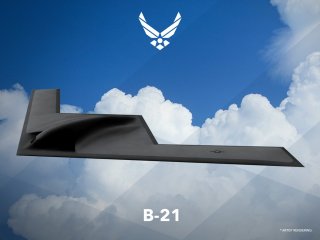The B-21 Bombers Biggest Fan: Hillary Clinton?
Many agree with Clinton that 100 planned planes aren't enough.
Here's What You Need to Remember: Upon examination, while many are in agreement that more B-21s are needed, Clinton’s reasoning seems somewhat flawed. B-21s, and especially stealth fighter jets such as the F-35, are needed for both longer range and “closer-in” short-range attacks.
Former Senator and Secretary of State Hillary Clinton is calling for the Pentagon to buy more new B-21 Raider Long Range Bombers as part of a broader argument that the Air Force is in need of massive, fast-paced modernization.
“We should welcome the arrival of the B-21 Raider, a long-range bomber under development that is designed to thwart advanced air defenses,” Clinton wrote in a Foreign Affairs essay.
Clinton is by no means alone. In fact, many senior Air Force leaders have been hoping to increase the number of acquired B-21s above the currently projected 100 planes planned.
An essay in Air Force Magazine, as cited by Military.com, quotes Global Strike Commander Timothy Ray calling for more than 200 bombers.
“We’ve said publicly that we think we need 220 bombers overall—75 B-52s and the rest B-21s, longterm,” Ray told Air Force Magazine earlier this year.
Clinton also makes the argument that the Pentagon should acquire fewer tactical fighter jets in favor of adding more bombers. However, many in the Air Force would also like to see both.
“The U.S. Air Force will have to focus less on short-range tactical fighter planes and more on long-range capabilities,” Clinton writes. By extension, Clinton says the U.S. should acquire fewer F-35s.
Upon examination, while many are in agreement that more B-21s are needed, Clinton’s reasoning seems somewhat flawed. B-21s, and especially stealth fighter jets such as the F-35, are needed for both longer range and “closer-in” short-range attacks.
Interestingly, despite the necessary and much-discussed technical emphasis now placed upon developing long-range, precision-guided “Stand-Off” weapons, “Stand-In” operations for “Direct Attack” are still very much in need, given the set of specific advantages they provide, according to a recent study released by the Mitchell Institute for Aerospace Studies.
The report, called “Long-Range Strike: Resetting the Balance of Stand-in and Stand-off Forces,” makes a specific and decided point of stating that a carefully calibrated mix of both approaches is what a fast-evolving modern Air Force needs. The study points to a series of significant variables with which to make this point, such as size, shape, scope and timing of attacks.
For instance, long range attacks can lack the needed immediacy or short-response time necessary for combat operations, and larger numbers of closer-in attack platforms are vital to increasing dwell time over targets. Needless to say, a larger number of bombers can also carry a larger number of bombs. More bombs might also be important when it comes to attacking heavily defended areas with many countermeasures expected to thwart, disable or intercept attacking weapons. Hitting penetrating targets, also, can be a tactical advantage somewhat specific to Stand-in weapons attacks conducted by stealthy, penetrating aircraft, the study explains.
“B-2s can deliver 5,000-pound direct attack “bunker buster” weapons and even the 30,000-pound GBU-57A/B Massive Ordnance Penetrator on hardened targets,” the study states.
Essentially, there will remain a clear and pressing need for attacking forces to retain an ability to penetrate heavily fortified and defended areas from both closer-in and longer ranges to successfully optimize offensive operations. This fundamental concept is why attack plans often follow a certain logical sequence, typically starting with stand-off weapons to soften air defenses, to be followed by stealth bombers intended to achieve air supremacy to open a crucial “air corridor” through which less stealthy, fast-maneuvering fighters can attack. There may be circumstances wherein close-in attack tactics are needed to assess shifting targets or track fast-changing combat circumstances.
Air-to-air engagements, especially when it comes to the prospect of any kind of great-power war, would doubtless be necessary as well, a circumstance underscoring the importance of having larger numbers of fighter jets such as the F-35 in the force.
Kris Osborn is the new Defense Editor for the National Interest. Osborn previously served at the Pentagon as a Highly Qualified Expert with the Office of the Assistant Secretary of the Army—Acquisition, Logistics & Technology. Osborn has also worked as an anchor and on-air military specialist at national TV networks. He has appeared as a guest military expert on Fox News, MSNBC, The Military Channel, and The History Channel. He also has a Masters Degree in Comparative Literature from Columbia University.
Image: Reuters

